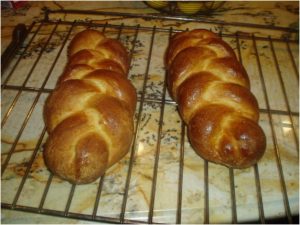I am not Jewish but I was inspired to make challah today. Maybe it was the start of Chanukah? Maybe it was our party coming up on Saturday? I first made challah when I was probably 16 and made it for a family event. One thing about challah is that is one of the easiest breads you will ever make and it looks the most impressive. I hadn’t made it in 30 years until today , and poof! It came out perfect! I am thinking of putting it in a basket with rolls next to our smoked pork and beef for next weekend’s graduation party. Stay tuned!
Mary
Challah
From The Bread Baker’s Apprentice (Canada, UK), by Peter Reinhart.
Ingredients:
4 cups (18 ounces) unbleached bread flour
2 tablespoons (1 ounce) granulated sugar
1 teaspoon (.25 ounce) salt
1-1/3 teaspoons (.15 ounce) instant yeast
2 tablespoons (1 ounce) vegetable oil
2 large (3.3 ounces) eggs, slightly beaten
2 large (1.25 ounces) egg yolks, slightly beaten
3/4 cup plus 2 Tbsp to 1-1/8 cups (7 to 9 ounces) water, at room temperature
2 egg whites, whisked until frothy, for egg wash
Sesame or poppy seeds for garnish
Instructions:
Stir together the flour, sugar, salt, and yeast in a mixing bowl (or in the bowl of an electric mixer). In a separate bowl, whisk together the oil, eggs and yolks, and 3/4 cup plus 2 tablespoons water. Pour the egg mixture into the flour mixture. Mix with a spoon (or on low speed with the paddle attachment) until all the ingredients gather and form a ball. Add the remaining water, if needed.
Sprinkle flour on the counter, transfer the dough to the counter, and knead for about 10 minutes (or mix at medium-low speed for 6 minutes with the dough hook), sprinkling in more flour if needed to make a soft, supple, but not sticky dough. The dough should register approximately 80°F (27°C).
Lightly oil a large bowl. Form the dough into a boule and transfer into the bowl, rolling it around to coat it with oil. Cover the bowl with plastic wrap. Ferment for 1 hour at room temperature.
Remove the dough from the bowl and knead for 2 minutes to degas. Re-form it into a ball, return the ball to the bowl, cover with plastic wrap, and ferment for an additional hour. It should be at least 1-1/2 times its original size.
Remove the dough from the bowl and divide it into 3 equal pieces for 1 large loaf, or 6 pieces for 2 loaves. (Or, for a celebration challah, divide it into 3 equal pieces and combine 2 of those pieces and form them into 1 large dough. Take this larger piece and divide it into 3 equal pieces. Take the smaller dough and divide it into 3 pieces as well; in the end, you will have 3 large pieces and 3 small pieces.) Regardless of the size of the loaves you decide to make, form each of the pieces into a boule, cover them with a towel, and let them rest on the counter for 10 minutes.
Roll out the pieces into strands, each the same length, thicker in the middle and slightly tapered toward the ends. Braid them using the 3-braid method shown. (If making the celebration challah, lay the smaller braid on top of the larger braid, gently pressing the smaller braid onto the larger to adhere.) Line a sheet pan with baking parchment and transfer the loaf or loaves to the pan. Brush the loaves with the egg wash. Mist the loaves with spray oil and cover loosely with plastic wrap or place the pan in a food-grade plastic bag.
Proof at room temperature for 60 to 75 minutes, or until the dough has grown to 1-1/2 times its original size.
Preheat the oven to 350°F (175°C) (325°F (160°C) for the celebration challah) with the oven rack on the middle shelf. Brush again with egg wash.
Bake for 20 minutes. Rotate the pan 180 degrees and continue baking for 20 to 45 minutes, depending on the size of the loaf. The bread should be a rich golden brown and register 190°F (88°C) in the center.
When done, transfer the bread to a rack and cool for at least 1 hour before slicing or serving.
Yield: Makes 1 large braided loaf, 2 smaller loaves, or 1 large double-braided celebration loaf

Leave a Reply
Want to join the discussion?Feel free to contribute!